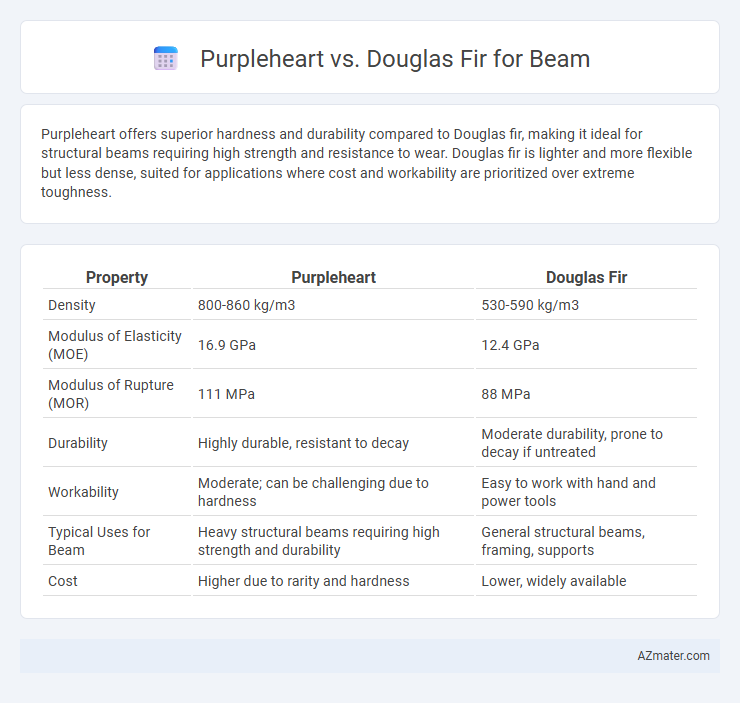Purpleheart offers superior hardness and durability compared to Douglas fir, making it ideal for structural beams requiring high strength and resistance to wear. Douglas fir is lighter and more flexible but less dense, suited for applications where cost and workability are prioritized over extreme toughness.
Table of Comparison
| Property | Purpleheart | Douglas Fir |
|---|---|---|
| Density | 800-860 kg/m3 | 530-590 kg/m3 |
| Modulus of Elasticity (MOE) | 16.9 GPa | 12.4 GPa |
| Modulus of Rupture (MOR) | 111 MPa | 88 MPa |
| Durability | Highly durable, resistant to decay | Moderate durability, prone to decay if untreated |
| Workability | Moderate; can be challenging due to hardness | Easy to work with hand and power tools |
| Typical Uses for Beam | Heavy structural beams requiring high strength and durability | General structural beams, framing, supports |
| Cost | Higher due to rarity and hardness | Lower, widely available |
Introduction to Purpleheart and Douglas Fir Beams
Purpleheart beams, known for their vibrant purple hue and exceptional density, offer superior strength and resistance to wear, making them ideal for heavy structural applications. Douglas fir beams, widely acclaimed for their high strength-to-weight ratio and natural durability, provide excellent load-bearing capacity and are commonly used in construction and timber framing. Both wood species deliver distinct advantages, with Purpleheart favored for its hardness and aesthetic appeal, while Douglas fir is valued for its versatility and availability.
Physical Properties Comparison
Purpleheart offers superior density and hardness compared to Douglas fir, with a Janka hardness rating of approximately 2,520 lbf versus Douglas fir's 690 lbf, making it more resistant to dents and wear. Purpleheart's higher specific gravity, around 0.85, contributes to greater strength and durability for beam applications, while Douglas fir's lower specific gravity of about 0.42 offers lighter weight but less load-bearing capacity. Moisture stability in Purpleheart is generally better, reducing the risk of warping or shrinking compared to the more porous Douglas fir.
Strength and Load-Bearing Capacity
Purpleheart wood exhibits superior strength and load-bearing capacity compared to Douglas fir, making it an excellent choice for structural beams requiring high durability. With a Janka hardness of approximately 2,520 lbf and a Modulus of Rupture around 18,800 psi, Purpleheart outperforms Douglas fir's Janka hardness of 660 lbf and Modulus of Rupture near 11,000 psi. Engineers often prefer Purpleheart for applications demanding exceptional tensile strength and resistance to bending under heavy loads.
Durability and Resistance to Decay
Purpleheart exhibits exceptional durability with a Janka hardness of 2,520 and high natural resistance to decay, making it ideal for heavy-duty beams exposed to moisture and insects. Douglas fir, while moderately durable with a Janka hardness around 660, requires treatment for prolonged outdoor use as it lacks the inherent decay resistance of Purpleheart. Selecting Purpleheart ensures longer-lasting structural integrity in conditions prone to rot and wood-boring pests.
Workability and Ease of Installation
Purpleheart wood boasts high density and hardness, making it more challenging to cut and shape compared to Douglas fir, which is prized for its softness and excellent workability. Douglas fir's lightweight nature allows for easier handling and faster installation, whereas Purpleheart requires specialized tools to prevent blade dulling and can extend project time. For beam applications prioritizing quick installation and ease of manipulation, Douglas fir is the more practical choice, while Purpleheart excels in durability but demands more effort during fabrication.
Cost and Availability
Purpleheart beams are generally more expensive than Douglas fir due to their exotic origin and high durability, making them a premium choice for structural applications. Douglas fir is widely available in North America, providing a more cost-effective and readily accessible option for construction projects requiring large beams. Both woods offer strength, but budget constraints and supply considerations often make Douglas fir the preferred material for bulk beam usage.
Environmental Impact and Sustainability
Purpleheart is a dense hardwood harvested primarily from South American rainforests, raising concerns about deforestation and habitat disruption despite its natural durability. Douglas fir, a fast-growing conifer native to North America, offers greater sustainability due to responsible forest management and certification programs like FSC, promoting reduced environmental impact. Choosing Douglas fir beams supports carbon sequestration and renewable timber resources, while Purpleheart requires careful sourcing to minimize ecological harm.
Applications and Best Use Cases
Purpleheart is ideal for decorative beams in high-end furniture and architectural elements due to its striking deep purple color and exceptional durability, making it suitable for interior applications with aesthetic emphasis. Douglas fir, with its strength, straight grain, and dimensional stability, is preferred for structural beams in residential and commercial construction, especially in framing, rafters, and heavy timber applications. Purpleheart excels in applications requiring hardness and unique appearance, while Douglas fir is best for load-bearing structures needing reliable performance and easy workability.
Maintenance and Longevity
Purpleheart beams offer exceptional durability and resistance to decay, requiring minimal maintenance over decades, making them ideal for long-lasting structural applications. Douglas fir beams, while less dense, benefit from regular maintenance such as sealing and inspection to prevent rot and insect damage, extending their functional lifespan significantly. When weighing maintenance needs against lifespan, Purpleheart's natural hardness and resilience often result in lower upkeep and prolonged structural integrity compared to Douglas fir.
Conclusion: Which Beam Material is Best?
Purpleheart offers exceptional hardness and durability, making it ideal for heavy load-bearing beams requiring resistance to wear and decay. Douglas fir provides excellent strength-to-weight ratio and stability at a more affordable price, suited for general construction and framing. For applications demanding long-term resilience and aesthetic appeal, Purpleheart is the superior choice; however, for budget-conscious and structural projects, Douglas fir remains highly effective.

Infographic: Purpleheart vs Douglas fir for Beam
 azmater.com
azmater.com